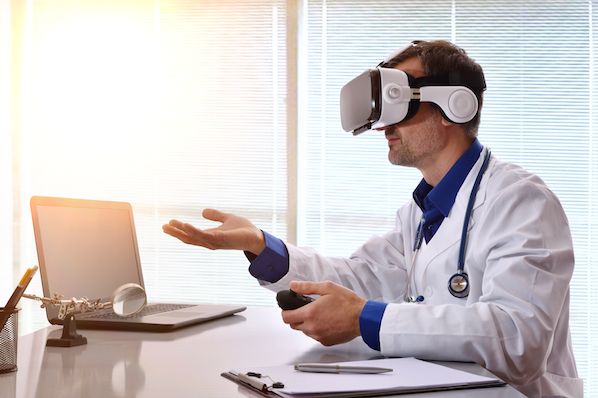- Like
- SHARE
- Digg
- Del
- Tumblr
- VKontakte
- Flattr
- Buffer
- Love This
- Save
- Odnoklassniki
- Meneame
- Blogger
- Amazon
- Yahoo Mail
- Gmail
- AOL
- Newsvine
- HackerNews
- Evernote
- MySpace
- Mail.ru
- Viadeo
- Line
- Comments
- Yummly
- SMS
- Viber
- Telegram
- JOIN
- Skype
- Facebook Messenger
- Kakao
- LiveJournal
- Yammer
- Edgar
- Fintel
- Mix
- Instapaper
- Copy Link
Did you know that the virtual and augmented reality global revenue is expected to grow from over $13 billion this year to more than $67 billion by 2024?
In fact, virtual reality startups are valued at more than $36 billion on paper.
For marketers, virtual reality’s surging popularity and ability to deeply engage people in immersive experiences and transport them to places they could only imagine going to makes it one of the most exciting emerging technologies in the industry.
But branded VR experiences are still in its infancy. Most marketing teams don’t know how to use the technology to its full potential.
To help you learn how to effectively leverage VR, we decided to make a list of the top VR startups and showcase how they’ve been able to use the technology to raise hundreds of millions of dollars in venture capital and build successful businesses.
If you want stay ahead of the VR curve in 2021 and beyond, check out these startups.
1. Magic Leap
Magic Leap, a company valued at over $6 billion, is an augmented reality platform focused on providing VR solutions to businesses.
With its wearable spatial solutions, you can easily incorporate VR/AR into your day-to-day. For example, you can use the headset to meet with coworkers and colleagues remotely, collaborate, share content, and even visualize complex 3D models.
Innovative businesses can use VR/AR to make remote collaboration easier.
2. Niantic
Niantic, the company that launched Pokemon Go in 2016, has become a top leader in augmented reality in that short 5 year time span. The business is even valued at over $4 billion.
This company focuses on building VR/AR games that get people moving. In fact, Niantic’s mission is to use emerging technology to enrich our experiences as human beings in the physical world.
This is a great company to keep an eye on to see how they market emerging VR/AR tech. Plus, you might even be able to use the games in your business as a part of a team building exercise.
3. Lightricks
Lightricks, a company founded in 2013 and valued at $1 billion, is an excellent leader in the VR/AR industry.
This business develops apps for social media marketers, creative content creators, or even small businesses. With these apps, you can use AR technology to edit social media posts, create videos with animated graphics, and more.
4. Surgical Theater
The third highest cause of death isn’t a ravenous disease or motor vehicle accidents — it’s medical errors. These errors are usually due to the extreme difficulty of treating each unique patient with absolute precision, especially during surgery.
It’s even harder to mitigate this prevalent problem because the only way surgeons can prepare for an operation is usually by planning and practicing surgery on a generic two-dimensional model of the human body.
Fortunately, with Surgical Theater, a VR system that can combine a patient’s MRIs, CT scans, and angiograms to reconstruct a 3D model of their brain’s unique anatomy, neurosurgeons can explore each of their patient’s arteries, bones, and tissue, accurately plan the surgery, and even practice the upcoming brain surgery on the 3D model.
Brain surgeons also use Surgical Theater to walk patients through their brain’s anatomy and the entire process of their surgery, making patients feel more informed about the details of their procedure.
Neurosurgeons can train with Surgical Theater similar to the way fighter pilots train with flight simulators, and some of the country’s top academic hospitals, like UCLA, NYU, University Hospitals Case Medical Center, Mayo Clinic, Mount Sinai, and Stanford University, have implemented the technology to advance their neurosurgery efforts.
5. VirtualSpaces
Selling a property that hasn’t been constructed yet is one of the biggest challenges real estate professionals face today. Blueprints don’t do the potential property justice — it’s almost impossible for people to sense its scale, size, height and depth. The human imagination can only visualize so much.
On top of that, most people are too busy during the week to tour property, so a lot of real estate professionals heavily depend on the weekends to showcase their realty. Getting people to walk through properties that are far away is also another challenge for real estate professionals.
But with VirtualSpaces, a mobile VR technology that can build immersive, three-dimensional visualizations of properties with only a blueprint, real estate professionals can overcome these common challenges.
With VirtualSpaces, real estate professionals can send digital properties to their potential clients at any time, transport them to the property from the comfort of their own couch, and walk them through its entire concept. And this allows them to provide unprecedented convenience, get potential clients excited about the property’s potential, and expedite their sales cycle.
6. Virtual Speech
Practicing a speech without an audience can be helpful, but the experience doesn’t truly emulate the pressure of an evaluating crowd. You can nail a dry run ten times in a row on your own, but when you actually step on stage and see an ocean of people staring at you, the nerves can debilitate your public speaking abilities.
Fortunately, VirtualSpeech can help you hone your public speaking skills — the app places you on a virtual stage with a virtual crowd, where you can practice your speech or presentation in front of an audience that imitates the mannerisms and sounds of real people. Their movements and noises are fully customizable, so you can ramp up the distractions and virtual judgement as much as possible.
At the end of your virtual speeches, the app will analyze and score your verbal and nonverbal communication. You can also add your own slides into your virtual presentation, practice for job interviews, learn how to network, and sell in a wide range of sales situations too.
Virtual Speech offers soft skills training courses and packages for individuals, teams, and companies too.
7. Neurable
Mind control of everyday objects might seem like science fiction today, but with virtual reality, it’s already a proven concept.
Using Neurable’s wireless brain-computer interface platform, people can interact with virtual and augmented reality applications with only their brain activity, avoiding lag-prone technologies like eye-tracking and voice commands.
Neurable leverages machine learning and a non-invasive method of monitoring brain activity called electroencephalography or EEG to accurately and instantly detect what your brain wants to do. And since using your brain is faster and easier than using controllers, brain-computer interface platforms like Neurable could be the future of VR.
8. Vivid Vision
Most healthcare VR startups provide solutions for doctors and surgeons, but Vivid Vision focuses on the people who truly need help: patients. By designing VR games that treat lazy eye, Vivid Vision provides a non-invasive cure to a common eye issue people can suffer from for their entire lives.
Vivid Vision also partners with over 180 eye clinics around the world to provide their most advanced and personalized treatment for lazy eye. But if you just want to do their vision therapy at home, you can get a prescription from your doctor to buy their less complex treatment program.
VR/AR has been around for a long time now, and the industry is only growing. As new startups continue to innovate, we’ll begin seeing VR/AR in several areas of our life, including work, healthcare, and entertainment.
Originally published Feb 12, 2021 7:00:00 AM, updated February 12 2021




![do-you-really-need-to-hold-that-meeting-[quiz-+-tips]](https://everythingflex.com/wp-content/uploads/2021/02/7861-do-you-really-need-to-hold-that-meeting-quiz-tips-150x150.jpg-23keepprotocol)